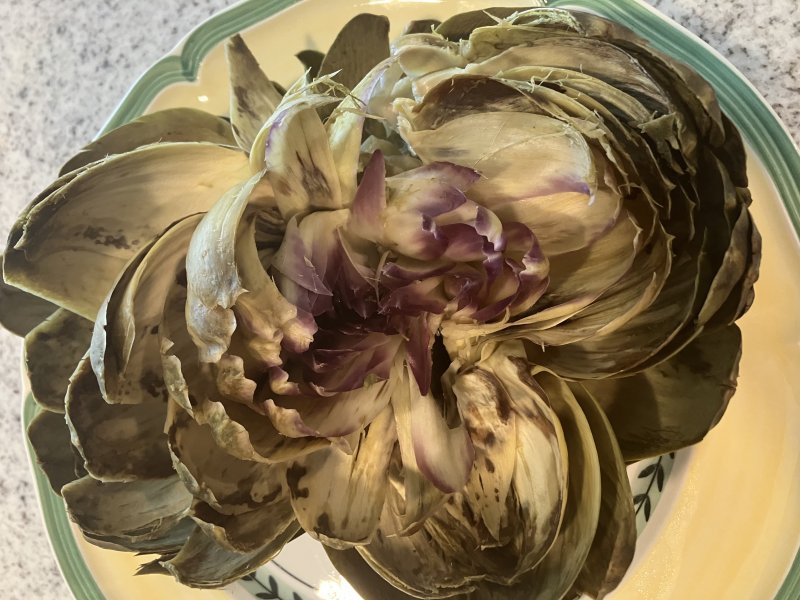Artichokes present a challenge worth accepting
Last week, my neighbor Christine gifted me an enormous artichoke. It was perfectly round, covered with tightly closed leaves, and heavy for its size — all signs that it was quite fresh. I trimmed off most of the stem end to create a flat surface at the base; this would help it sit upright in the pot as it steamed in lemon-infused water for about 40 minutes.
Before I describe the challenging process of enjoying an artichoke, I’ll share some of its backstory. According to food historian Alan Davidson, what we now know as the globe artichoke is likely the cultivated descendant of the wild cardoon, a member of the thistle family that originated along the Mediterranean Sea in Northern Africa and Italy.
Plants grow to about 3 or 4 feet tall, and the edible flower bud is harvested before it blooms. If allowed to bloom, the bright-purple flowers offer a showy addition to a perennial garden. The plant’s name derives from the Italian words “articiocco” and “articoclos,” the latter of which comes from a word meaning pine cone, a reasonable description of the appearance of its layered leaves.
Starting with the Ancient Greeks and Romans, artichokes were enjoyed year-round, as the plants thrived in those temperate climates. By the time of the first century AD, the Moors of Northern Africa were cultivating artichokes in Granada, Spain, and the Saracens became associated with artichokes in Sicily. Over the next 1,500 years, the plant was widely cultivated throughout Europe, arriving in France and England in the 16h century, where it developed a reputation as an aphrodisiac.
Artichokes arrived in the United State in the 1800s, brought by French immigrants to Louisiana and by the Spanish to the Monterey area of California. During the decades that followed, cultivation became concentrated in California, where today almost all the artichokes in this country are commercially produced. Due to the labor-intensive process of hand harvesting, artichokes have high production costs, exacerbated by their short shelf life and limited production per plant.
In Italy, the buds are harvested when they are quite small. They’re typically served fried and eaten whole. Once the bud has become larger, it is often served with a savory stuffing tucked between the leaves. My favorite preparation is the steamed artichoke. To eat it, each leaf is removed, one at a time, and dipped into melted butter. You then place the base of the leaf between your upper and lower teeth and draw it away, scraping off the tender flesh and discarding the sharp top.
Once all the exterior leaves are gone, it’s time to harvest the meaty heart by scooping out the fuzzy choke in the center. In the photo, the purple-colored leaves are the tiniest edible set surrounding the prickly hairs covering the heart. Once you’ve eaten them, use a spoon or knife to scrape away and discard these sharp threads. Voila, the heart!
One note about eating artichokes is that they contain the acid cynarin, which has the unusual quality of changing how your taste buds perceive flavors. A fun experiment is to take a sip of water when you finish your artichoke; it will taste sweetened.
Here are recipes for steaming and stuffing artichokes.
Steamed Artichokes
2 whole artichokes
juice of 1 lemon
Fill a large pot with 3 inches of water and bring to a boil over high heat. Rinse the artichoke and trim off the stem close to the bottom to create a flat surface. Trim off about one inch from the top leaves and remove any dried leaves from the outside. Once the water comes to a boil, add the lemon juice and place the artichokes in the pot. Cover and steam until tender, about 30 minutes. Serve with melted butter or aioli for dipping. Yield: 2 servings.
Stuffed Artichokes*
4 large artichokes
1 lemon, halved
1 C breadcrumbs
1/2 C grated Parmesan cheese
1/4 C chopped fresh parsley
3 minced garlic cloves
1 t salt
1/2 t pepper
1/4 C olive oil
1/2 C chicken broth
Preheat oven to 375 F. Trim off the tops and stems of the artichokes; snip off the sharp tips of the leaves. Rub with lemon to prevent browning. Open the center leaves and use a spoon to scoop out the fuzzy choke. Arrange the artichokes, stem side down, in a baking dish; set aside. In a bowl, combine breadcrumbs, Parmesan cheese, parsley, garlic, salt and pepper. Drizzle in olive oil and mix until well combined. Fill each artichoke with the breadcrumb mixture, making sure to get some filling between the leaves. Pour chicken broth into the pan. Cover with aluminum foil and bake until the leaves are tender and the filling is golden brown, about 45-50 minutes. Remove from oven. Drizzle with additional olive oil if desired. Yield: 4 servings.
*Adapted from The Barefoot Contessa.






















































